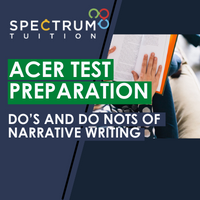For those of you preparing to sit the ACER Scholarship test, I’m sure this is a nervous time of the year. As of today, there is only a week or two until thousands of students across Victoria will sit the ACER tests, in hope of achieving a scholarship at their desired schools. The test is designed to test all types of knowledge and contains four sections.
-Written Expression (Essay)
-Mathematics
-Humanities (Reading Comprehension and Interpretation)
-Written Expression (Narrative)
Today, I will be focusing on what is, for some students, the most daunting section: the writing of a creative narrative. This section of the exam takes only 25 minutes, and students are required to respond creatively and fluently to an unseen prompt. This is no easy task!
So today, I present a list of 10 Do’s and Do Not’s for Narrative Writing, which should hopefully help your child quickly improve their stories.
1. DO limit the scope of the story.
Your child has 25 minutes to write a story. Obviously, it will not be a very long story. Your child will not be able to cram in a whole day, week, or month worth of action into the story. In such a short time, your child will only have time to describe one or two significant events. Encourage your child to limit their story to a small timeframe, and to only one or two locations. For example, below are two events that I might write a story about. Which one do you think is more appropriate for a 25 minute story?
1. My family and I travelled to Europe and went to France, Holland and Germany.
2. When in Paris, my family and I went all the way to the top of the Eiffel tower.
And remember, stories do not have to start with the main character waking up in the morning. Stories should begin at an exciting or interesting moment.
2. DO have a plan for structure.
A good story is a well structured story. A well structured story will have certain sections which perform certain roles. These include.
Orientation – The beginning of a story, when we meet the characters, find out where they are and what they are doing.
Example: I am at Footscray Market shopping with my mother.
Problem – Something happens, which forces the main character to make a decision or attempt a difficult task.
Example: I bend over to tie my shoe and when I look up, I can’t find my mother.
Rising action – Several interesting or exciting events happen as a result of the problem.
Example: I run around to all the stalls and ask the shopkeepers if they’ve seen my mother. I start to worry that I will never find her.
Climax – The most exciting part of the story, in which the main character solves the initial problem.
Example: I start to cry, but then I notice a face in the crowd. It’s my mother! She looks worried, so I run up and give her a hug.
Resolution – The conclusion of the story, in which we find out what happens to the characters after the climax.
Example: My mother and I got some jam donuts and then went home.
3. DO make your characters engaging.
Characters should be distinct from one another. The reader should be able to tell the difference between two characters just by the way they talk and act. If all the characters act the same, a story will get confusing and dull. Encourage your child to think about ways in which they can make their characters different from one another. Maybe one is old and one is young… Maybe one is male and one is female… Maybe one is polite and one is rude…
4. DO create a mood in your story.
Encourage your child to think about what mood they want to establish in their story. Is it a scary story? Is it a sad story? Is it a funny story? These moods can be easily created through descriptions of people, places and the weather. For example, read the two passages below and think about what mood each of the passages is setting.
1. The thunder crashed and the rain poured down in thick torrents. Sam sheltered under his dark cloak, which covered his crooked face in shadows.
2. The sun was peeking out between the clouds. Sam smiled, enjoying the warmth of the sun on his skin.
5. DO use vivid verbs.
Some verbs are interesting. Some verbs are boring. Verbs such as walk, say, eat, drink, hit and laugh often don’t create a very strong image in the mind of readers. Encourage your child to experiment with using more interesting verbs to create stronger images. Here are some examples.
Say – shout, whisper, bellow, groan, scream, mention, confess, declare, moan
Eat – nibble, gobble, peck, scoff, consume, swallow, much, devour
Laugh – cackle, giggle, chuckle
Walk – tiptoe, trudge, amble, pace, gallop, run, sprint
Note: interesting verbs only work if they are used properly. Make sure your child is only using verbs that they understand. Otherwise they might confuse the reader.
6. DO NOT tell what you can show.
This is the first rule that most writers learn. A good writer will always let their readers know important information without telling them outright. For example, read the two sentences below.
1. Paul is mean. Nobody likes him, but we are all to afraid to tell him.
2. Paul shoved me into my locker with his shoulder and laughed. It hurt a lot, but I faked a smile. “How’s it going, Ron,” he asked. “Good,” I mumbled, trying to sound friendly. Paul smiled an ugly smile. “See ya, midget,” he said. “Bye Paul,” I sighed.
Both of these sentences are giving the same information, but the second sentence lets the readers figure it out for themselves. Readers don’t like being told how to feel. It’s far more interesting to show a situation and allow the action and the dialogue to speak of itself.
7. DO NOT use 2 words when 1 word will do.
The biggest problem with young writers is that they tend to write sentences like this:
“The big, gigantic man was scary and terrifying. He had big, round, red, bloodshot eyes and his smile was evil and cruel.”
Have a look at this sentence and think, are any of these words unnecessary? For example, saying “big, gigantic man” is just the same as saying “gigantic man.” As a rule, encourage your child to use a maximum of one or two adjectives to describe a noun. It will force them to be more careful about what words they choose.
“The gigantic man was terrifying. He had big, bloodshot eyes and his smile was cruel.”
8. DO NOT add unnecessary details.
This is a simple point. Your child is not writing the life story of their character. They should only include details that are relevant to the story. The reader does not need to know that the main character has six brothers and a pet dog, unless that information is important to the story. Otherwise, it takes up precious time and words.
9. DO NOT include too many characters.
This is a similar point to point 8. In 25 minutes, your child does not have very much time to introduce characters. If they try to include too many, they may run out of time. Additionally, if there are too many characters in a story, the reader is likely to get confused as to who is who. As a rule, a short story should have 2-4 characters.
10. DO NOT forget the importance of dialogue.
Dialogue is amazing. It can tell the reader what is happening in the story. It can build suspense. It can reveal important information. It can tell the reader how the character feels about a certain event. It can help to build an impression of the character’s personality. It is important to consider that people will say different things in different ways depending on who they are, what situation they are in, and how they feel.
For example, how do you think people in the following situations would say thankyou?… What words would they use? How would they say it?
1. A mother thanking a fireman for saving her baby.
2. A child who has received a terrible present from his grandmother.
3. A busy waiter who has been given a very small tip from a rude customer.
4. A bank robber who thanking the bank manager for handing him a bag of money.
I will leave you today with a prompt. Give this prompt to your child and encourage them to write a story in 25 minutes. Let me know in the comments how they went, and what they wrote about!
Prompt: You have to confess an important secret to someone very important to you.


